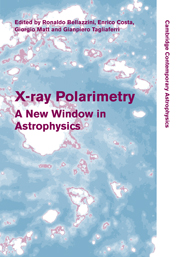Book contents
- Frontmatter
- Contents
- List of contributors
- Preface
- 1 X-ray polarimetry: historical remarks and other considerations
- Part I Polarimetry techniques
- 2 Scattering polarimetry in high-energy astronomy
- 3 Photoelectric polarimeters
- 4 Bragg crystal polarimeters
- 5 X-ray polarimetry with the photon-counting pixel detector Timepix
- 6 High-energy polarized photon interactions with matter: simulations with Geant4
- 7 The GPD as a polarimeter: theory and facts
- 8 Ideal gas electron multipliers (GEMs) for X-ray polarimeters
- 9 Broad-band soft X-ray polarimetry
- 10 Feasibility of X-ray photoelectric polarimeters with large field of view
- 11 Angular resolution of a photoelectric polarimeter
- 12 Development of a Thomson X-ray polarimeter
- 13 Hard X-ray / soft gamma-ray polarimetry using a Laue lens
- Part II Polarized emission in X-ray sources
- Part III Future missions
- Author index
- Subject index
9 - Broad-band soft X-ray polarimetry
from Part I - Polarimetry techniques
Published online by Cambridge University Press: 06 July 2010
- Frontmatter
- Contents
- List of contributors
- Preface
- 1 X-ray polarimetry: historical remarks and other considerations
- Part I Polarimetry techniques
- 2 Scattering polarimetry in high-energy astronomy
- 3 Photoelectric polarimeters
- 4 Bragg crystal polarimeters
- 5 X-ray polarimetry with the photon-counting pixel detector Timepix
- 6 High-energy polarized photon interactions with matter: simulations with Geant4
- 7 The GPD as a polarimeter: theory and facts
- 8 Ideal gas electron multipliers (GEMs) for X-ray polarimeters
- 9 Broad-band soft X-ray polarimetry
- 10 Feasibility of X-ray photoelectric polarimeters with large field of view
- 11 Angular resolution of a photoelectric polarimeter
- 12 Development of a Thomson X-ray polarimeter
- 13 Hard X-ray / soft gamma-ray polarimetry using a Laue lens
- Part II Polarized emission in X-ray sources
- Part III Future missions
- Author index
- Subject index
Summary
We developed an instrument design capable of measuring linear X-ray polarization over a broad band using conventional spectroscopic optics. A set of multilayer-coated flats reflects the dispersed X-rays to the instrument detectors. The intensity variation with position angle is measured to determine three Stokes parameters: I, Q, and U – all as a function of energy. By laterally grading the multilayer optics and matching the dispersion of the gratings, one may take advantage of high multilayer reflectivities and achieve modulation factors >50% over the entire 0.2–0.8 keV band. This instrument could be used in a small orbiting mission or scaled up for the International X-ray Observatory. Laboratory work has begun that would demonstrate the capabilities of key components.
Introduction
The soft X-ray band (0.1–1.0 keV) should prove to be a fruitful region to explore for polarized emission. One concept, the Polarimeter for Low Energy X-ray Astrophysical Sources (PLEXAS), proposed the use of multilayer-coated mirrors tuned to 0.25 keV as Bragg reflectors. As in similar Bragg reflection systems, the PLEXAS design had a narrow bandpass, reducing its attractiveness for astrophysical observations because one expects polarization to be energy dependent, so a wide bandpass is desired.
Marshall described a method to overcome this limitation by using transmission gratings to disperse in the incoming X-rays. Following up on this approach, Marshall suggested an arrangement that can be used in missions ranging from a small explorer to the International X-ray Observatory (IXO).
- Type
- Chapter
- Information
- X-ray PolarimetryA New Window in Astrophysics, pp. 66 - 71Publisher: Cambridge University PressPrint publication year: 2010



